|
Small-Medium Yellow-Orange Underwings: Wingspans: 70mm and under
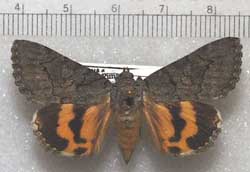
| Catocala chelidonia;
45-50mm. Fw fuscous grey. Reniform, subreniform spots concolourous, with
srf closed, sometimes lighter and brown. Pm line thin, distinct, two upper teeth slightly produced.
Hw orangish. Black median band swollen near cell, angles 90 d toward, not to
im. Fringes off-white opp. orange, grey
opp. outer band. Some orange near apex inside thin, distinct sm line.
|
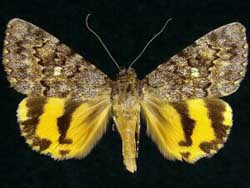
| Catocala benjamini;
50 mm. Catocala benjamini reportedly flies as the nominate susbspecies in Arizona, Nevada, southern California and southern Utah.
Catocala benjamini mayhewi flies in southern California. Catocala benjamini jumpi
flies in the Kofa Mountains of Arizona. Catocala benjamini ute flies in
southeastern Utah in the Balaneed Rock Area at elevations around 1610 m.
|
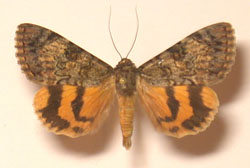
| Catocala desdemona;
55-70mm. Fw gc is light mottled grey with greenish blue cast. Double reniform spot
brown. Subreniform spot large, lighter brown, closed; tail extends to pm line.
Upper pml teeth moderately produced, next two teeth, not at all. Next produced, thick,
rounded, distinct inward loop below.
Hw ib turns 90 toward im. Ob broken; large orange apical area.
|
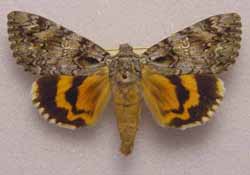
| Catocala ilia zoe male;
65mm.
unconfirmed
Fw light grey, considerable brown scaling. Double reniform spot has brown center, thinly outlined in black, widely outlined in white,
then thinly outlined in black. Subreniform spot indented on both inner & outer side, just above its tailed extension,
which may/ may not be open.
Aml black, distinct, pointed, triangular shaped indentation just above im. Pm line darker along upper half.
southern and western.
|
Small-Medium Orange-Salmon Underwings: Wingspans: 65mm and under
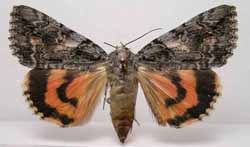
|
verrilliana; Verrill's Underwing;
45-60mm.
Closed, subtriangular subreniform spot large,
light in colour. Light patch runs from subreniform
diagonally to costa. Dark area on basal side of
aml, light patches between pml and subterminal line
distinguish this species. Note orange hw fringe. July-September, oaks.
|
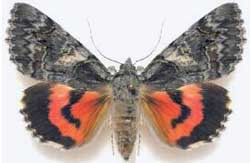
| Catocala ophelia;
Ophelia Underwing: 52mm:
Fw dark grey, am/pm lines
relatively smooth except for two jagged spikes in pm
near apex. Considerable brown shading outside
subterminal line. Hw pink-deep red, black
median band constricted in
center, ending before im. Black
submarginal border is quite broad near apex. White fringe
heavily checked. Southwestern
|
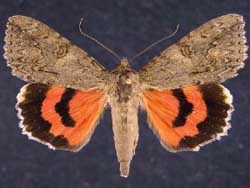
|
faustina;
58 mm
Forewing markings are relatively weak on almost uniform drab grey-brown ground colour.
The two middle "teeth" in the forewing postmedial line are relatively short.
The hindwing inner band is narrow and truncated well before the inner margin.
Black extenssions into white hindwing fringe continue as thin lines along veins. June until October; willows
|
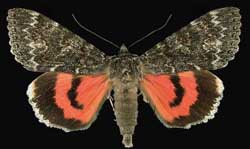
|
californica;
65mm.
Fws dark, gritty. Markings indistinct. Dark, large reniform spot; am and pm lines indistinct.
Subterminal line inwardly lined with light scales. Hw fringe white, checked halfway to outer edge with black,
black lines on veins extending through fringe. Some orange bleeding at apex. Black median band ends
well before im. June until August; willow or walnut??
|
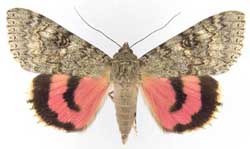
| Catocala hermia;
Hermia Underwing: 58-68mm; pinkish:
Fw uniform, grey-brown/clay coloured, thin, contrasting medial lines.
Distinct large double reniform spot. Large concolourous subrenifrom spot usually open.
Hw pinkish red, relatively even, narrow black bands. Inner band ends before im.
Fringe white, checked, "bleeding" along outer band, near apex.
|
Large Yellow-Orange-Salmon Underwings: Wingspans: 65mm - 75mm
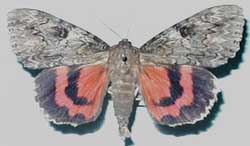
|
irene; Irene's Underwing;
65-75mm.
Fw grey brown, darker upper half basal area, around reniform spot, indistinct arc near apex.
Sbrnfrm spot lighter, open into pm area.
Hw median black band pointed before reaching im. Outer band scalloped near a. a..
Probably southeast; poplars, willows
|
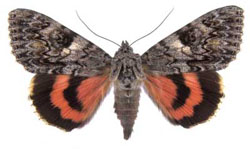
|
faustina allusa. unconfirmed
White interior outline of terminal line is typical of this species
and two jagged upper "teeth" of postmedial line are typical of most
poplar feeders. There is also a dark bar a few mm up from inner
margin of the forewing. Subreniform spot and area interior and above tend to be lighter. willows and poplars
|
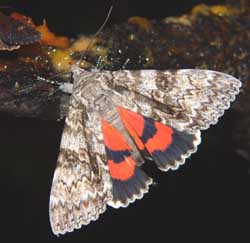
| ** 8821
semirelicta; Semirelict Underwing;
wingspan: 65-75mm.
Fw ground colour white with dark lines and shadings.
Diffuse dark bar runs from center of basal area to outer margin a
few mm above anal angle. Note regular dentation of st line.
Inner black bar on lower wing usually terminates well before
inner margin.
The form "atala" has forewing that is uniformly grey.
Unijuga is usually larger and has less contrasting black lines.
Inner black bar on unijuga usually reaches inner margin.
Tim Dyson image.
|
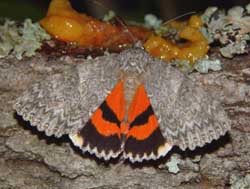
| ** 8822
meskei TM; Meske's Underwing;
65-75mm.
Fws less distinctly marked compared to unijuga,
some red-orange at the hindwing apex and just inside the
fringe along the outer margin in meskei that is lacking in unijuga.
Fw subreniform spot is opened or connected to the
postmedian line. The hindwing postmedian band nearly straight,
turned in and tapering near anal angle.
Tim Dyson image. |
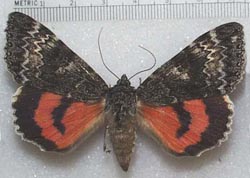
| Catocala grotiana;
Grote's Underwing: 70-80mm:
The white outlines outside the postmedial and inside the subterminal lines make this species stand out.
The hindwing inner black band is even and relatively thin and terminates well before the inner margin.
The fringe is heavily checked and charcoal grey along the inner margin.
Hindwings can be orange or red. August until September; willows
|
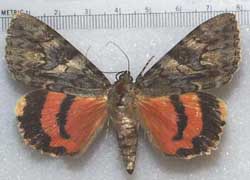
| Catocala jessica;
Jessica Underwing: 75mm: Fw is bluish grey with some brown scaling. Am line is irregular, meets i m almost at midpoint.
Pm line has one upper tooth produced, second is much less so. Third is little more than a sharp point
on smooth curve to fourth tooth, somewhat produced over opening of large subreniform spot.
Reniform spot is double and dark in darker region of median area.
|
Large Orange-Salmon Underwings: Wingspans: 75mm and larger
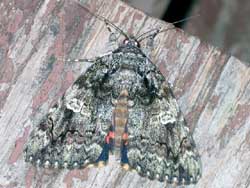
| ** 8801
Catocala ilia; Ilia;
wingspan: 65-82mm. unconfirmed
Several different forms,
most have characteristic white area in and around
reniform spot. Diffuse dark arc running from this
spot to just below apex. Subreniform spot squarish, concave inner and outer edges
and elongated constriction connecting it to pml.
White dots near fw om in character
with the overall "contrasting" appearance.
|
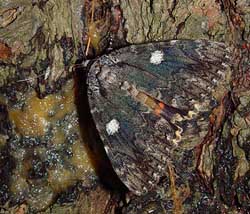
| ** 8801
Catocala ilia; Ilia;
form conspicua
In this form the entire reniform spot is heavily suffused with white scaling on
an otherwise darker ground colour. Hence the form name "conspicua".
Tim Dyson image.
|
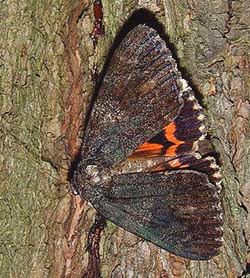
| ** 8801
Catocala ilia; Ilia;
form satanas
In this melanic form the entire forewing, including the reniform spot is very dark. Hence the form name "satanas".
The dark basal streak is still evident on this form.
Tim Dyson image.
|
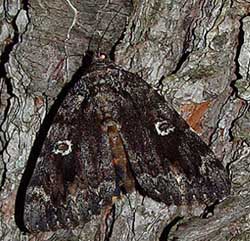
| ** 8801
Catocala ilia; Ilia;
form normani
In this semi-melanic form the entire forewing, excluding the reniform spot, is relatively dark.
The brownish, kidney-shaped center of the reniform spot is outlined in white.
The basal streak and subapical arc are still visible.
July until September, probably southeast; oaks
Tim Dyson image.
|
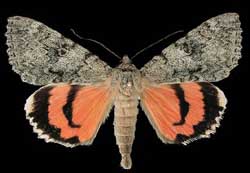
| Catocala junctura;
Joined Underwing; 67-85mm.
Fw usually dark brownish-gray to evenly powdered
blue-grey w/o significant markings. Doubled reniform spot
often obscure. Thin, slightly darker am, pm
lines run from costa to im, not widely
spaced at im. Hw salmon/ orange-pink, narrow inner black band
turns in sharply, does not meet dark-haired im. May-October; poplars and willows
|
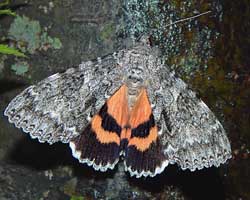
| ** 8805 unijuga;
Once-married; wingspan: 70-90mm: Catocala unijuga has a
fairly wide black inner band (almost reaching inner margin) in
hindwing and very distinctive patterning in forewing. Meskei tend to
have narrower band and dustier (less distinct) looking forewing.
Semirelicta tend to have inner bands that terminate well before
inner margins.
Also note the very white fringe on both the forewings and hindwings.
Carroll Rudy image.
|
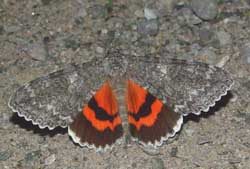
| ** 8805 unijuga;
Once-married; 70-90mm.
Form agatha has a much darker, evenly grey forewing.
Hindwings have some darker hairs in basal area.
Note very white fringe on both forewings & hindwings.
June to october, willows
|
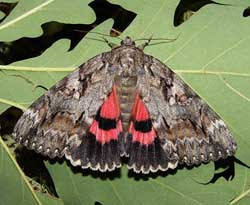
| aholibah;
80-90mm: Fw is mix of grey and brown, with preponderance of brown in subterminal area.
Double reniform spot has diffuse brown outline of inner oval. Subreniform spot is small,
distinctly outlined in black,
light coloured and does not connect to pm line. Upper two teeth of pm line are elongate
and are followed by relatively smooth line til next tooth below the subreniform spot.
Hindwing salmon or pinkish.
|
Large Black Underwings (Banded): Wingspans: 70-80mm
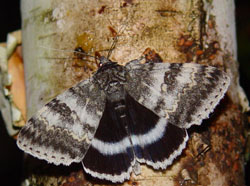
| ** 8803 Catocala relicta
;
Forsaken, White, Relict; 70-80mm:
Considerable variation with regard to black/white
concentrations on fws.
Typical specimens have basal and subterminal areas with
blackish scales.
Black hws, with brilliant even white inner band and
white fringe, are distinctive. June until October, probably N.& E; poplars and willows
|
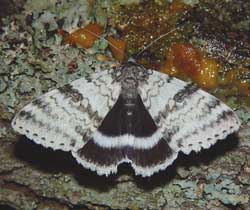
| ** 8803 Catocala relicta
;
Forsaken, White, Relict; 70-80mm:
Considerable variation with regard to black/white
concentrations on fws.
Form clara: basal and subterminal
areas predominantly white.
Typical specimens have basal and subterminal areas with
blackish scales. Black hws, with brilliant even white inner band and
white fringe, are distinctive. June until October, probably N.& E; poplars and willows
|
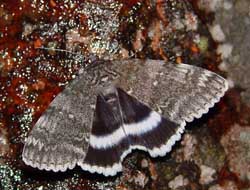
| ** 8803 Catocala relicta
;
Forsaken, White, Relict; 70-80mm:
Considerable variation with regard to black/white
concentrations on fws.
Form phrynia:
evenly dusted with grey over entire forewing.
Typical specimens have basal and subterminal areas with
blackish scales. Black hws, with brilliant even white inner band and
white fringe, are distinctive. June until October, probably N.& E; poplars and willows
|
|
|
|



























